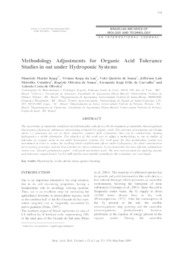Methodology adjustments for organic acid tolerance studies in oat under hydroponic systems.
Methodology adjustments for organic acid tolerance studies in oat under hydroponic systems.
Author(s): KOPP, M. M.; LUZ, B. K. da; SOUZA, V. Q. de; COIMBRA, J. L. M.; SOUSA, R. O. de; CARVALHO, F. E. F. de; OLIVEIRA, A. C. de
Summary: The occurrence of anaerobic conditions in hydromorphic soils favors the development of anaerobic microorganisms that produce phytotoxic substances representing primarily by organic acids. The selection of promising oat (Avena sativa L.) genotypes for use in those situations requires field evaluations that can be cumbersome, making hydroponics a viable alternative. The objective of this work was to adjust a methodology to use in studies of tolerance to organic acids in oat under hydroponic systems. For such goal, the best germination system was determined in order to reduce the seedling initial establishment effects under hydroponics, the ideal concentration for screening genotypes and the best variable for stress evaluation. It was found that the most efficient germination system was "pleated germination paper" with small and husked seeds. The best concentration for studying organic acid tolerance ranged from 2.3 to 6.2 mM and the most suitable variable for the evaluation was root length.
Publication year: 2009
Types of publication: Journal article
Unit: Embrapa Dairy Cattle
Keywords: Genetic breeding, Levels, abiotic stress, phytotoxicity
Observation
Some of Embrapa's publications are published as ePub files. To read them, use or download one of the following free software options to your computer or mobile device. Android: Google Play Books; IOS: iBooks; Windows and Linux: Calibre.
Access other publications
Access the Agricultural Research Database (BDPA) to consult Embrapa's full library collection and records.
Visit Embrapa Bookstore to purchase books and other publications sold by Embrapa.

